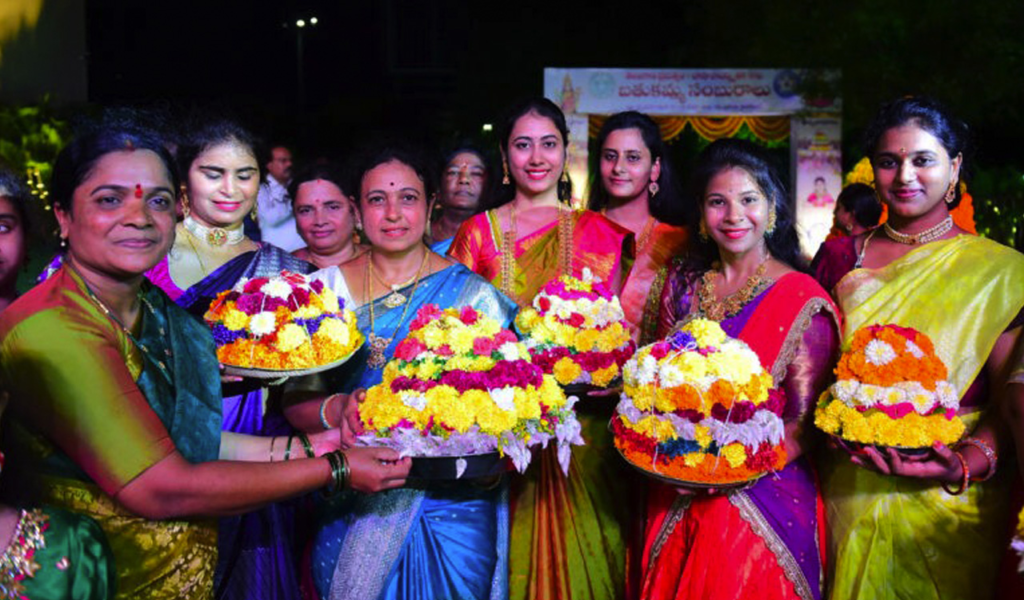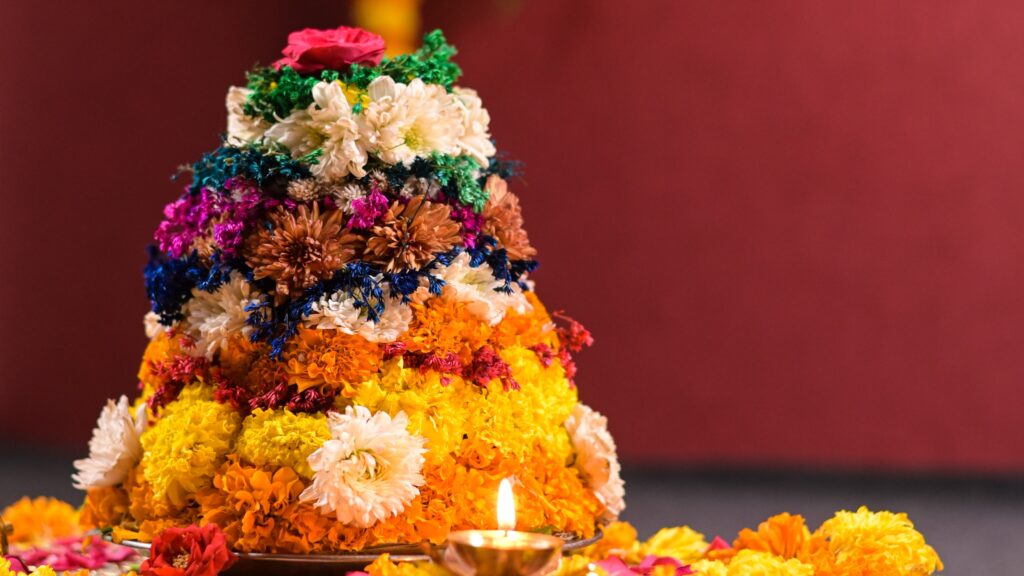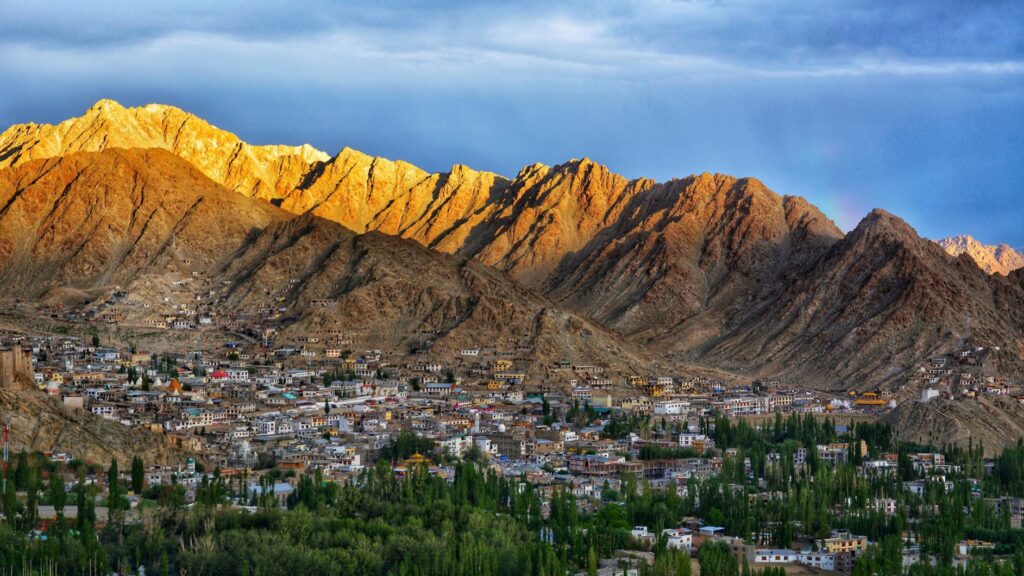In today’s article, we journey all the way to the south of India to a 9-year-old state to explore a regional event close to the people’s hearts. I’m confident you guessed Telangana, India’s youngest state.
Bathukamma is a traditional celebration held in Telangana. It is dedicated to Goddess Gauri devotion and honors womanhood and women’s power in society.
The celebration entails making exquisite floral arrangements to represent the deity and praying. Bathukamma demonstrates the intimate bond between humans and nature, displaying thankfulness for nature’s contributions. Through traditional music, dances, and customs, the event develops social relationships, promotes unity, and protects Telangana’s cultural legacy.
It is celebrated during the Hindu month known as Bhadrapada, which usually falls in September or October according to the Gregorian calendar. The festival begins on the day of Mahalaya Amavasya (the new moon day) and continues for nine days. Bathukamma also often coincides with Navaratri, leading up to Dussehra. Thus, resulting in a joyful season that includes both the goddess’s worship and the triumph of virtue over evil.
What inspired the name Bathukamma? The name “Bathukamma” is derived from two words: “bathuku” which means “life” and “amma” which means “mother.” “Bathukamma” can be roughly translated as “Mother Goddess of Life” in English.

During Bathukamma, ladies create stunning floral arrangements utilizing a variety of seasonal flowers to represent nature’s wealth. The flowers are arranged in a conical shape, with a turmeric-molded figure of the goddess Gauri (Matha Gowri/parvati) in the center, on top of the floral arrangement. This floral arrangement, known as Bathukamma, forms the focal point of the celebrations. This arrangement represents the human connection to nature.
Women praise the goddess and show their appreciation for nature by singing, dancing, and performing traditional folk dances around the Bathukamma. The event celebrates the Telangana region’s cultural heritage, joy, and great respect for the divine feminine.
Bathukamma is observed for 9 days. Every day of the nine-day Bathukamma festival is dedicated to a different subject or manifestation of the goddess. the flowers utilized and the offerings presented to the deity differ as well.
During these nine days, women form groups and visit each other’s houses, carrying their beautifully prepared Bathukamma. The hosting house lady invites other women in as part of this visitation by applying a vermilion dot (kunkumma) on the forehead, applying turmeric to the feet, and exchanging gifts known as “vayanam.” Clothes, bangles, accessories, fruits, and household things are examples of suitable gifts. And they place their bathukamma’s in the centre and joyfully dance around it, praising the goddess.
The 9 days which are celebrated with 9 types of bathukammas with 9 types of sacred food offerings and vayanam’s are as follows:
Engili Pula Bathukamma: On the first day, which is Mahalaya Amavasya (the new moon day) engili pula bathukamma is celebrated. Ladies gather “Celosia” (gunugu) and “marigold” (banthi) flowers for bathukamma. Sesame seeds, broken rice, and rice are combined and offered to the goddess as a sacred food offering. Vayanam is offered to ladies in the form of “betel leaves”(tamalapaku) and “holy basil leaves”(Tulasi).

Atkula Bathukamma: The second day, ashvayuja shudda padyami (the first day of the bright fortnight), is known as atkula bathukamma. On this day, bathukamma is decorated with “Tanner’s cassia” (tangedu), “Chrysanthemum (chamanthi)”, “celosia”, and “Marigold” flowers. Women prepare “Split Moong Dal (sappidi pappu),” “Jaggery,” and “Flattened Rice” combined together as meal offerings. Vayanam is offered in form of flattened rice.
Muddapappu Bathukamma: Muddapappu Bathukamma begins on the third day, Ashvayuja Shudda Vidiya (the second day of the bright fortnight). Bathukamma is decorated with flowers such as “Jasmine,” “Hibiscus,” “Lotus,” and “Star Jasmine” on this day. A dish known as “Muddapappu” (a lentil dish), “jaggery,” and “milk” are prepared and served to the goddess.
Nanabiyyam Bathukamma: Nanabiyyam Bathukamma is celebrated on the fourth day, Ashvayuja Shudda Tidiya (the third day of the bright fortnight). On this day, “Celosia” and “Tanner’s cassia” are used to make bathukamma. “Soaked rice” (Nanbettina biyyam) is offered to the goddess as a sacred food offering. Vayanam is made from soaked rice combined with jaggery.
Atla Bathukamma: On the fifth day, which is Ashvayuja Shudda chavithi (the fourth day of the bright fortnight) atla bathukamma is commenced. This Bathukamma is a magnificent arrangement of “Tanner’s cassia” (tangedu), “Chrysanthemum (chamanthi),” “Hibiscus,” and “pumpkin flowers.” Women get up early at this time to make exquisite uppidi biyyam Attlu (wheatlet crepes) as a sacrifice to the goddess. These uppidi biyyam attlu are provided as vayanam.
Aligina Bathukamma: It is thought that the goddess was upset on the sixth day, which is Ashvayuja Shudda panchami (the fifth day of the bright fortnight), hence the bathukamma is not celebrated on this day. The word alagina/alagadam implies “upset.”
Vepakayala Bathukamma: Vepakayala bathukamma begins on the seventh day, which is Ashvayuja Shudda shasti (the sixth day of the bright fortnight). Bathukamma is arranged with “Celosia” (gunugu), “Tanner’s cassia” (tangedu), and rose flowers. Sakinalu (Riceflour formed into the fruits of the Neem tree and deep-fried) food offerings to Goddess. Therefore, this day is known as Vepakayala Batukamma. As vayanam, the same sakinalu are provided.

Vennamuddala Bathukamma: On the eighth day, which is Ashvayuja Shudda saptami (the seventh day of the bright fortnight), bathukamma is arranged with “Celosia” (gunugu), “Tanner’s cassia” (tangedu), grass rose (gaddi puvu), and rose blossoms. Goddess is offered sesame seeds, jaggery, ghee, and butter. Vayanam is given in form of sesame seeds and jaggery.
Saddula Bathukamma: The most important day of the celebration is Saddula Bathukamma, which is Ashvayuja Shudda asthami (the eighth day of the brilliant fortnight) which is also Purnima (full moon day). On this day, bathukamma is decorated with whatever form of flower that is available. Sacred food offerings to goddess include perugannam saddi (curd rice), Chinthapandu Pulihora Saddi (tamarind rice), Nimmakaya Saddi (lemon rice), Kobbari Saddi (coconut rice), and Nuvvula Saddi (sesame rice). As vayanam, sattu pindi (spice combination) and turmeric are used.
Women dress up in traditional clothes, carry their elegantly arranged Bathukammas on their head, and take part in processions, singing and dancing before immersing the Bathukammas in water. Bathukamma is immersed in water as part of the last rite known as “Nimmajjanam” or “Visarjan,” which represents Goddess Gauri’s departure. This deed concludes the event and depicts the goddess’ return to her holy dwelling. Bathukamma’s immersion in water is also an expression of thanks to nature, particularly to water, which maintains crops during the monsoon season. Furthermore, the act of immersion is thought to purify the surroundings and bring prosperity.
Bathukamma is strongly entrenched in Telangana’s cultural customs and history. The celebration is significant in the context of Telangana’s distinct cultural identity, and its observance has been passed down through generations in the state. Bathukamma’s rituals, songs, and customs are inextricably linked to Telangana’s native customs, folklore, and beliefs. As a result, the event has become an intrinsic part of Telangana’s cultural history, with a strong sense of regional pride and attachment.
Overall, the celebration of Bathukamma has cultural and spiritual importance, encapsulating the festival’s end as par with the cyclical aspect of existence in life.
Tech enthusiast turned writer. Simplifying coding concepts, sharing free resources, and offering campus placement tips. Passionately writing on topics I love.




